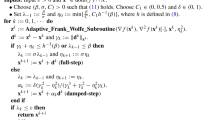Abstract
In this paper, we study minimal zero norm solutions of the linear complementarity problems, defined as the solutions with smallest cardinality. Minimal zero norm solutions are often desired in some real applications such as bimatrix game and portfolio selection. We first show the uniqueness of the minimal zero norm solution for Z-matrix linear complementarity problems. To find minimal zero norm solutions is equivalent to solve a difficult zero norm minimization problem with linear complementarity constraints. We then propose a p norm regularized minimization model with p in the open interval from zero to one, and show that it can approximate minimal zero norm solutions very well by sequentially decreasing the regularization parameter. We establish a threshold lower bound for any nonzero entry in its local minimizers, that can be used to identify zero entries precisely in computed solutions. We also consider the choice of regularization parameter to get desired sparsity. Based on the theoretical results, we design a sequential smoothing gradient method to solve the model. Numerical results demonstrate that the sequential smoothing gradient method can effectively solve the regularized model and get minimal zero norm solutions of linear complementarity problems.
Similar content being viewed by others
References
Cottle, R.W., Pang, J.-S., Stone, R.E.: The Linear Complementarity Problem. Academic Press, Boston (1992)
Facchinei, F., Pang, J.S.: Finite-Dimensional Variational Inequalities and Complementarity Problems. Springer Series in Operations Research, vol. I and II. Springer, New York (2003)
Ferris, M.C., Mangasarian, O.L., Pang, J.-S.: Complementarity: Applications, Algorithms and Extensions. Kluwer Academic Publishers, Dordrecht (2001)
Ge, D., Jiang, X., Ye, Y.: A note on complexity of \(\ell _p\) minimization. Math. Program. 129, 285–299 (2011)
Natarajan, B.K.: Sparse approximate solutions to linear systems. SIAM J. Comput. 24, 227–234 (1995)
Fukushima, M., Pang, J.S.: Some feasibility issues in mathematical programs with equilibrium constraints. SIAM J. Optim. 8, 673–681 (1998)
Fukushima, M., Tseng, P.: An implementable active-set algorithm for computing a B-stationary point of a mathematical program with linear complementarity constraints. SIAM J. Optim. 12, 724–739 (2002)
Lin, G., Fukushima, M.: New reformulations for stochastic nonlinear complementarity problems. Optim. Methods Softw. 21, 551–564 (2006)
Luo, Z.Q., Pang, J.-S., Ralph, D.: Mathematical Programs with Equilibrium Constraints. Cambridge University Press, Cambridge (1996)
St-Pierre, D.L., Louveaux, Q., Teytaud, O.: Online sparse bandit for card games. In: Lecture Notes in Computer Science. Advances in Computer Games, vol. 7168, pp. 295–305 (2012)
Althöfer, I.: On sparse approximations to randomized strategies and convex combinations. Linear Algebra Appl. 199, 339–355 (1994)
Auger, D.: Multiple tree for partially observable Monte–Carlo Tree Search. In: Proceedings of the 2011 International Conference on Applications of Evolutionary Computation, vol. 1, pp. 53–62 (2011)
Xie, J., He, S., Zhang, S.: Randomized portfolio selection with constraints. Pac. J. Optim. 4, 87–112 (2008)
Blog, B., van der Hoek, G., Rinnooy Kan, A.H.G., Timmer, G.T.: The optimal selection of small portfolios. Manag. Sci. 29, 792–798 (1983)
Chen, X.J., Xu, F., Ye, Y.: Lower bound theory of nonero entries in solutions of \({\ell }_2-{\ell }_p\) minimization. SIAM J. Sci. Comput. 32, 2832–2852 (2010)
Chen, X., Zhou, W.: Smoothing nonlinear conjugate gradient method for image restoration using nonsmooth nonconvex minimization. SIAM J. Imaging Sci. 3, 765–790 (2010)
Zhang, C., Chen, X.: Smoothing projected gradient method and its application to stochastic linear complementarity problems. SIAM J. Optim. 20, 627–649 (2009)
Acknowledgments
This research was supported by the National Basic Research Program of China (2010CB732501), the National Natural Science Foundation of China (71271021,11001011), the Fundamental Research Funds for the Central Universities of China (2013JBZ005) and the Scientific Research Fund of Hebei Provincial Education Department(QN20132030). The authors thank the editor and the anonymous referees for their valuable comments for improving the presentation of this paper.
Author information
Authors and Affiliations
Corresponding author
Additional information
Communicated by Lionel Thibault.
Rights and permissions
About this article
Cite this article
Shang, M., Zhang, C. & Xiu, N. Minimal Zero Norm Solutions of Linear Complementarity Problems. J Optim Theory Appl 163, 795–814 (2014). https://doi.org/10.1007/s10957-014-0549-z
Received:
Accepted:
Published:
Issue Date:
DOI: https://doi.org/10.1007/s10957-014-0549-z
Keywords
- Minimal \(\ell _0\) norm solutions
- Linear complementarity problems
- Z-Matrix
- \(\ell _p\) regularized minimization
- Sequential smoothing gradient method




